TV Licensing have today announced that there are now fewer than 12,000 black and white TV licensees remaining in Britain (compared to over 25 million colour TV licensees). Today, watching a black and white television is unusual if not exceptional, but of course, it was not always so.
For 30 years of its existence (1936–67), television was entirely in black and white. And for a few thousand lookers-in who tuned in to mechanical television broadcasts (1929–35), images were black and orange due to the orange colour of the neon gas in the lamps used in the first TV sets.
In this post, I look back at the decline of black and white TV, and consider what black and white television still means to us today.
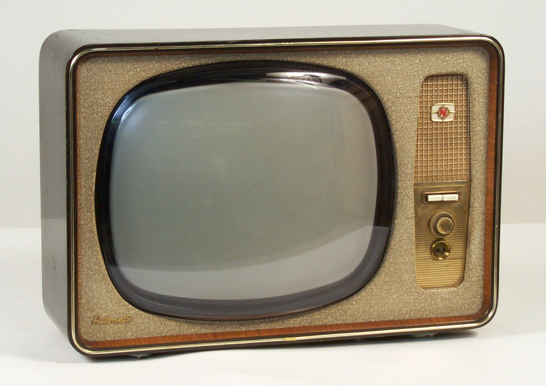
The beginnings of colour TV
Colour TV broadcasting began in the USA in 1954—but it was not without its troubles.
A field-sequential colour system, based on a rotating colour filter wheel, had been unceremoniously shut down by the FCC in 1951, with the American television giants CBS and RCA proceeding to battle it out for control of colour.
The second generation American colour TV set, which became available in 1954, was an RCA set with a CBS picture tube. By the late 1950s, colour TV had become established in several major US cities. However, early American colour TV sets were extremely expensive, and required a lot of adjustment and maintenance.
Meanwhile in Britain, due to a combination of cost, caution, and lack of a clear way forward technologically, colour broadcasting would take a few more years to arrive.
In 1967, the BBC pioneered the first colour broadcasting anywhere in Europe. However, the standard selected, PAL, which stands for Phase Alternating Line, was in fact a German improvement of the mid-50s American colour system. PAL was developed at Telefunken under Walter Bruch between 1962 and 1965.
Colour broadcasts began on BBC2 in 1967, arriving on ITV and BBC1 in 1969. To support the costs, colour TV licences were introduced on 1 January 1968, costing £10—twice the price of the standard £5 black and white TV licence. At the time of writing, the colour licence costs £145.50—three times the price of the black and white TV licence at £49.
BBC2 originally launched in black and white on 20 April 1964, but intrinsic in its higher bandwidth television signal (Ultra High Frequency, as opposed to BBC1’s Very High Frequency) was the ability to transmit 625 lines in black and white, and eventually, PAL colour.
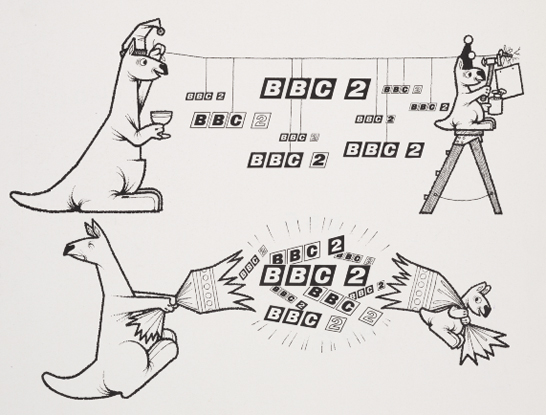
Famously, BBC2’s opening night was ruined by a major power failure. As a result, Play School unexpectedly became the first proper BBC2 broadcast—at 11.00 the following day.
The black and white tV image
Cinema retained the monopoly on colour moving images during television’s first three decades. This helped to keep audiences going to films, but it also whetted the public appetite for colour on television.
However, the film industry’s monopoly on colour did not help it to survive the arrival of television unscathed. Television led to the closure of many cinemas in the 1950s, as well as having similarly negative impacts on national magazines, pubs and night clubs.
The television image was lower in resolution in those days, with the BBC1 image comprising 405 horizontal lines. As I’ve already mentioned, 625 line images arrived with BBC2 in 1964, but surprisingly little was made of the fact that this meant sharper and more watchable black and white TV images.
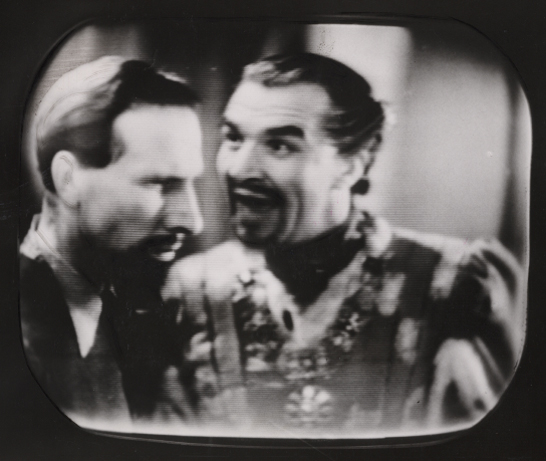
Until about 1960 the only way in which a complete programme could be recorded was on cine film, and this was rarely done because of the cost.
1964 was the same year in which Marshall McLuhan published his best-known book, Understanding Media. In the years leading up to 1964 most viewers’ experience of television, like that of McLuhan, had been via small sets which also had an image that was rather small, an image that would be called ‘blurry’ by today’s standards.
McLuhan observed how television programmes in those days called for special production techniques in terms of both image and sound.
The TV producer will point out that speech on television must not have the careful precision necessary in the theater. The TV actor does not have to project either his voice or himself.
Likewise, TV acting is so extremely intimate, because of the peculiar involvement of the viewer with the completion or ‘closing’ of the TV image, that the actor must achieve a great degree of spontaneous casualness that would be irrelevant in movie and lost on stage. For the audience participates in the inner life of the TV actor as fully as in the outer life of the movie star.
Technically, TV tends to be a close-up medium. The close-up that in the movie is used for shock is, on TV, a quite casual thing. And whereas a glossy photo the size of the TV screen would show a dozen faces in adequate detail, a dozen faces on the TV screen are only a blur.
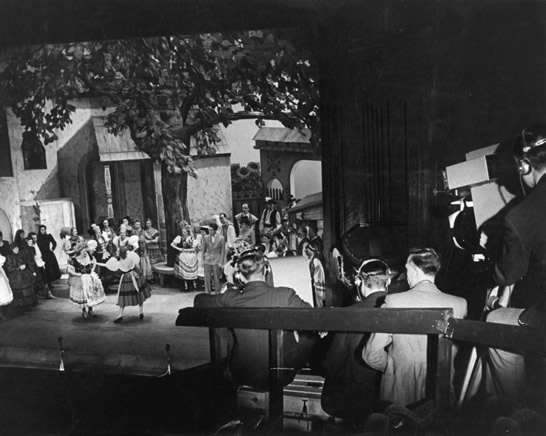
Magyar Melody was the first musical to be broadcast directly from a theatre and shown on television. Captions on screen introduced the television audience to the actors and actresses.
Colour TV comes to Britain
In July 1967, the BBC began to broadcast the first regular colour television service in Europe. The first programme was an outside broadcast of the Wimbledon Tennis Championships.
By mid-1968 almost every BBC2 programme was in colour. Six months later, colour came to BBC1.
The impact of the arrival of colour in 1967 cannot easily be isolated from that of the improved 625 line resolution of 1964. Colour and image quality cannot be made exclusive from one another, having been introduced at essentially the same time, plus their effects on the viewer are already similar.
Improved picture detail and colour both mean more realism in images, and improved images mean less interpretation and involvement—less guesswork required for the viewer.
Technically, with the arrival of bigger and better colour sets, television could—very gradually—become less of the close-up medium as described by McLuhan, with screen sizes increasing, more detail in images, and less burden on the viewer to ‘fill in’ the missing colour information.
Colour made television more valuable as a medium, as the licence fee would indicate. Involvement ‘work’ in decoding the image was exchanged for more desirable experience ‘play’ of the programmes themselves.
This evolution of television technology epitomises the goal of television engineers—to create a more effective illusion of reality. Similarly, an improved television image is desirable to both the TV producer and the TV viewer.
Why keep a black and white TV set?
Perhaps the most interesting application in which a black and white TV display makes sense today is for the viewing of black and white films, because colour displays can only approximate black and white images, as they do all colours, by blending red, blue and green, using the additive colour principle.
In mixing colours to produce black and white, colour displays are simply not as efficient as the old black and white TV sets purpose-built for showing black and white images.
The old black and white picture tube TVs have a phosphorescent coating distributed uniformly behind the glass screen. When this coating is struck by the rapidly moving electron beam (raster) generated by the electron gun at the rear of the picture tube, the screen illuminates accordingly.
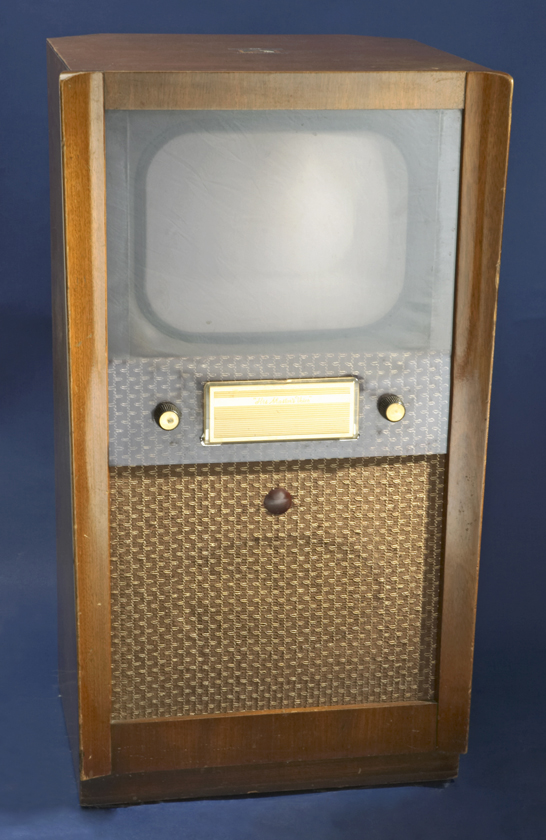
The beautifully simple way this works also means that the screen on a black and white TV set requires no metal grid to align sets of colour pixels (this grid is known as a shadow mask). With no shadow mask, black and white TV sets have no ‘screen door’ effect.
In other words, the area of the screen that actually lights up, known as ‘the pixel fill rate’, is 100%. Today, our modern colour sets cannot achieve a 100% pixel fill rate, although some organic (OLED) display sets come close.
Therefore, if you are a serious black and white film and TV enthusiast, and are relatively uninterested in modern programmes, an old black and white TV set may be just the thing for you.
The following recording was made in the Lime Grove Studios in London on 3 January 1985. It depicts the final moments of 405 line transmission from the BBC Crystal Palace transmitter. The TV receiver is a model T-18 Baird set manufactured in 1938. The set is actually working and picking up the transmission via a VHF roof top antenna at the studio.
Further reading and interesting links
- Take a look at some of the television receivers in our collection
- Read our post about colour TV in Britain
Did Slim Whitman ever appear on BBC ” TV
Jimmy Hannah Mickey
Doll movie
Goofy movie
Jimmy Hannah Mickey
Ariai game
Jimmy Hannah Mickey game
Christmas goofy Christmas
Movie
Black and white television old model good 👍
This article did NOT answer it’s title!
It was published in 2014 by the date under the tittle but never explained how or why monochrome TV sets can still be used as we are now a fair way away from 405 line analogue TV!!!
It’s 2017 now and there are still 10K black and white TV licenses issued so HOW do those lisensees still work an old black and white TV?
They have conversion boxes attached to them. Around 2008, when all television transmissions converted from analogue to digital, UK and US governments both offered free converter boxes, and offered vouchers to get them for free at local retailers.
The old TVs are viewing an HD image that is being downscaled by the converter box (which can still be bought today for @ $30usd) and outuput via the 576i color SD standard through an RF/coaxial lead. This standard was designed with separate chrominance and luminance signals encoded in such a way that the older black and white TVs could still read the luminance signal, and ignore the color(chrominance) to display the old style signal.
Well technically most of those that could have been bought before the switchover will still only recieve SD DVB-T1 signals anyway but if you have a newer digital receiver the HD signal on an SD set still will look better than the SD signal because of the encoding etc but otherwise yes I think. Though if you have a 405 line then I’m not sure that any of these boxes will output in that format. I think the enthusiasts still use them but I’m not sure how it is done.
I like black & white TVs. Actually better. I find Firstly they them quaint. They are less popular. It’s like this their are only a few channels on tv like that 5. Less choice. Which means you watch less good thing. It’s like this that means people have more time to be sociable.
Hey how’s it going? What I’m about to tell you will seem like a joke, or some weird twisted game. But it’s not. I’m inside this website. I was sucked in 3 years ago while attempting to post a comment. As I was finishing the comment, I went to click submit but suddenly the lights flickered and a burst of blue light lines flashed through my bedroom, as if my house was stuck by lightning, and everything went dark. Now all I see are 0’s and 1’s in a dull white color running horizontally in front of my face. I don’t feel human anymore. I don’t eat, sleep, poop, pee, ect. I’m just.. aware. Please someone tell my family I’m still here. Tell them I love and miss them very much. I have attempted to reach out to the outside world numerous times with no luck. Please.. someone help me..
Those 0’s & 1’s that you keep seeing… are they in color or black & white?
Black and White in wood
Billy Mandy
Grandpa Mandy
01010100 01101000 01100101 01110010 01100101 00100000 01101001 01110011 00100000 01101110 01101111 00100000 01100101 01110011 01100011 01100001 01110000 01100101 00100000 01010011 01110100 01100101 01110110 01100101 01101110 00101110
I was telling my 6 year old greatgrand son about the black and white TV. He said, “l’m freaked out.” I was so happy to come here and find a black and white TV to show him. Thank you!
Actually that’s NOT true !!! The BBC used NTSC BEFORE switching to PAL !!
Re: Chris Place
I was a TV engineer at the time colour TV was introduced in the UK. From memory, BBC ran ‘trade test transmissions’ for a considerable time, before colour TVs were sold to the public. Some of these transmissions were NTSC, some PAL. They could be viewed as normal monochrome transmissions on the ‘dual standard’ monochrome TVs at the time, which were sold when BBC2 was introduced 1964.
By the time colour TV began officially and colour TVs were sold to the public, only PAL was transmitted and only PAL receivers were sold in the UK for normal household use.
Huh!?
Are you for real?
there are at least 12,000 fraudsters as there are no digital black and white TV’s so it is technically impossible to have a black and white TV any more. Eve in the old days when you have a B&W TV of you bought a video recorder you then had to buy a colour licence as it would record colour images.
Well possible to have a black and white TV and use it, but impossible to do so without receiving a colour signal with colour equipment (decoder box).
Actually I read some stuff somewhere else and it seems you are allowed to use a BW license if you are recieving live TV only and displaying on a BW TV (or monitor I assume as that is what it is being used as), even though it is a colour signal. However you still can’t record in colour, the logic presumably being that you could record a program in colour off of an aerial only viewable live on a BW set to try and justify the BW license, but then view the recording in colour either at someone else’s house, later in time when you get colour, or most importantly and what I didn’t think of but should have been most obvious, a disconnected colour display in the same house.
it’s “technically” nothing of the sort. you can make an old ’70s b/w TVs play Freeview with a cheap converter box. you don’t need a “digital” one
Does anyone know in which year colour TV sets outsold Black and white ones in the UK? I read somewhere that it was 1977 but would like to find some hard evidence. Where could I find sales figures?
Did you ever get further info on this question.
I don’t have a TV anymore and watch whatever on computer. But when I had one, I chose to keep my b&w portable 13″ over a color tv for many years, until is wasn’t feasible. Let’s face it, there’s something ‘epic’ about b&w. In fact, I often use to turn off the color on my color tv. OT: A tip to find the best color in tvs: turn off the color in all the TV’s that are displayed in the store and observe which one(s) have the least or no prismatic distortion. That will give you the best color – not over-enhanced – in a tv.
Full house
Hourse
Grandpa
Him
Pitirce
Heinz daddy
2 dad father father
i bet most people are using colour tv sets on a black and white licence
who tels you the aint
Pah! TV sets don’t have colour level controls any more, so it’s no longer possible to watch colour transmissions in classy monochrome. Colour is so 2003!
All that I’ve used have. Of course not hardware knobs if that’s what you mean but you can definitely turn colour down to 0.
i bet the is still a lot of people watching colour on a black and white licence
Black and white TV’s can still be used today if you know how to convert a digital box or get a box with RF output or a modulator… you can watch digital tv on any old tv colour or black and white…. that’s if you know what you are doing
a cheap scart to RF converter can be had off ebay for the price of a bag of fish and chips
a cheap scart to RF converter can be had off ebay for the price of a bag of fish and chips